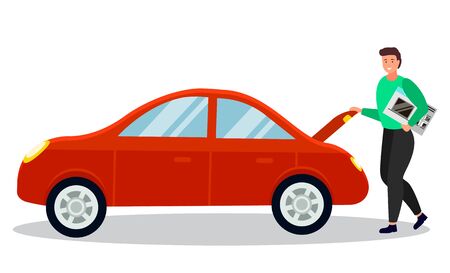Understanding Indian Family Needs
When choosing a car for your family in India, it’s important to consider the unique requirements that set Indian families apart. Most Indian households, especially in Tier-2 and Tier-3 cities, often comprise joint-family structures, meaning multiple generations may travel together. This increases the need for spacious interiors and flexible seating arrangements. Daily commuting patterns also play a big role—many Indian families face long commutes through crowded city roads or even rough rural terrain. Urban families typically navigate heavy traffic and require cars that are easy to park and manoeuvre, while rural families look for vehicles with higher ground clearance to tackle uneven roads. Additionally, cultural preferences like accommodating elders comfortably and ensuring safety for children are top priorities. These factors make it essential to evaluate both sedans and SUVs not just for their looks or brand image, but for their ability to meet these practical needs safely and efficiently.
Safety Features: Sedan vs SUV in India
When it comes to family safety, understanding the safety features of sedans and SUVs available in the Indian market is essential. Indian families often travel with children and elders, so prioritising advanced safety features is a must. Both sedans and SUVs have evolved over the years to include modern safety technologies, but there are key differences worth noting.
Common Safety Features Compared
| Feature | Sedan | SUV |
|---|---|---|
| Airbags | Dual front airbags standard, up to 6 in higher variants | Dual front airbags standard, up to 7 or more in premium models |
| ABS with EBD | Standard across most models | Standard across most models, sometimes with additional traction control |
| Build Quality | Lighter build for better mileage; some models use high-strength steel for added protection | Generally sturdier and heavier; higher ground clearance offers better protection in collisions |
| Child Safety Locks & ISOFIX Mounts | Available in mid to top variants | More commonly offered, even in base variants due to focus on family buyers |
Airbags & ABS: Essential for Indian Roads
Bumpy roads, unpredictable traffic, and monsoon conditions make airbags and ABS (Anti-lock Braking System) non-negotiable for Indian families. While both sedans and SUVs now offer these as standard, SUVs often go further by offering curtain and knee airbags in higher trims. This can be a crucial point for larger families seeking extra peace of mind.
Build Quality Differences
The rugged build of an SUV generally provides a feeling of greater security, especially during highway journeys or when driving through rough terrains found in many parts of India. However, modern sedans also feature reinforced cabins and crumple zones designed for urban safety. Some budget-friendly sedans may compromise slightly on material strength to keep prices competitive, so it’s wise to check crash test ratings before deciding.
Family Tip:
If you frequently drive on highways or rural roads with your family, an SUVs robust structure might be preferable. For city dwellers focused on daily commutes and fuel efficiency, a sedan with top-tier safety features can also serve your needs well.

Space and Comfort for Large Families
When it comes to choosing the right car for Indian families, space and comfort become top priorities, especially considering our joint family culture and the need to travel together during festivals or long outstation journeys. Let us compare sedans and SUVs to see which segment better suits these requirements.
Interior Space
Sedans generally offer a comfortable cabin for four to five passengers, but their rear seat space can sometimes feel cramped, especially for adults on longer drives. On the other hand, SUVs are designed with more headroom and legroom, making them ideal for accommodating larger families and ensuring every member travels comfortably.
Seating Comfort
For Indian families who value both daily commuting and weekend getaways, SUVs often come with higher seating positions and adjustable seats that provide better visibility and comfort. Many SUV models also offer third-row seating, which is perfect when you have extra relatives or friends joining in during festival visits or weddings. Sedans focus more on plush interiors and good support but might not always match the flexible seating arrangements of an SUV.
Luggage Capacity
Family trips in India often mean carrying extra luggage, gifts, or even home-cooked food during festivals. While sedans provide a decent boot space, SUVs usually boast much larger boot capacity with foldable rear seats, allowing for easy storage of large suitcases or shopping bags from local markets. This added flexibility makes SUVs a practical choice for those frequent outstation journeys.
Indian Family Preferences
In the context of Indian road conditions—be it narrow city lanes or bumpy rural roads—SUVs tend to offer more robust suspension and ground clearance without compromising interior comfort. For many Indian families who prioritise togetherness and festive outings, these aspects make SUVs stand out as the go-to option for space and comfort.
Verdict: Which Is Better?
If your primary concern is maximizing passenger comfort and cargo space for frequent family outings or traditional gatherings, SUVs generally edge out sedans in the Indian context. However, if your family is smaller and values a smoother ride with luxury interiors, a sedan can still be a good fit. Ultimately, the decision should reflect your familys size, travel habits, and cultural needs.
4. Performance on Indian Roads
When it comes to choosing the right family car, understanding how sedans and SUVs perform on Indias diverse roads is crucial. Our road conditions vary significantly—from congested city streets to rugged rural roads and challenging monsoon-affected stretches. Let’s look at how both car types handle these situations, so you can make an informed decision for your familys safety and comfort.
City Traffic Handling
Sedans: Sedans are generally more compact and offer better maneuverability in heavy traffic, which is a daily reality in cities like Mumbai, Delhi, and Bangalore. Their lower ground clearance makes parking easier in tight spots but can be a disadvantage over large speed breakers or potholes.
SUVs: Modern compact SUVs have become quite popular in urban India thanks to their higher seating position, giving better visibility. However, larger SUVs may feel bulky in narrow lanes and crowded markets. Still, they handle uneven patches and waterlogged areas better than most sedans.
Rural Roads & Challenging Terrains
Sedans: On rural or unpaved roads, sedans may struggle due to their low ground clearance and softer suspension setups. Bumpy roads can lead to underbody scraping, making them less suitable for frequent village or farmland commutes.
SUVs: With higher ground clearance and robust suspension systems, SUVs are better equipped for rough terrains found in many Indian towns and villages. Whether it’s crossing broken roads or handling loose gravel, SUVs generally provide a smoother ride.
Monsoon-affected Areas
Sedans: During monsoons, waterlogged roads are common in many parts of India. Sedans risk stalling if the water level is high because of their lower air intakes and limited wading depth.
SUVs: The higher wading capacity of most SUVs means they can navigate flooded streets with less risk of engine damage. This makes them a practical choice if you live in regions frequently affected by heavy rainfall.
Quick Comparison Table
| Road Condition | Sedan Performance | SUV Performance |
|---|---|---|
| City Traffic | Easy to park; agile; sometimes struggles with potholes | Better visibility; handles poor roads well; bulkier to park |
| Rural Roads | Prone to underbody damage; less comfortable ride | Smooth ride; handles rough terrain easily |
| Monsoon/Waterlogging | Risk of stalling; limited water wading depth | Higher wading depth; safer during floods |
The Bottom Line for Indian Families
If your daily commute is mostly within the city with well-maintained roads, a sedan could serve you well. But if you often drive through rough patches, rural areas, or face harsh monsoon conditions, an SUV might be the safer and more versatile family choice for Indian roads.
5. Maintenance and Ownership Costs
When choosing between a sedan and an SUV for your Indian family, it’s important to consider the long-term maintenance and ownership costs. These costs can significantly impact your monthly budget and overall satisfaction with your car.
Maintenance Expenses: Sedans vs SUVs
Sedans generally come with lower maintenance costs compared to SUVs. Their components are often less expensive, and the routine service intervals are usually more affordable at local workshops or authorised service centres. On the other hand, SUVs typically have larger tyres, heavier suspension systems, and advanced technology, which can lead to higher servicing bills over time. In India, where road conditions can be tough on vehicles, especially in smaller cities or rural areas, regular maintenance is crucial for both body types. However, since sedans are lighter and less complex mechanically, their wear-and-tear parts tend to last longer and cost less to replace.
Fuel Efficiency Considerations
Fuel prices in India are always on the rise, so fuel efficiency is a major factor for most families. Sedans usually offer better mileage compared to SUVs due to their lighter build and more aerodynamic design. This translates into lower running costs for daily commutes or highway drives. While modern compact SUVs have improved in this aspect, they still lag behind sedans in terms of kilometres per litre. For a typical Indian household that values every rupee spent on petrol or diesel, a sedan might prove more economical in the long run.
Service Network Availability
India’s automotive market is vast, but not all brands have an equally strong service network across urban and rural areas. Popular sedan models from established brands like Maruti Suzuki, Hyundai, and Honda benefit from widespread service centres even in smaller towns. Many new SUV models, especially those from international or premium manufacturers, may have limited after-sales support outside metros and Tier-1 cities. This could mean longer waiting times for parts or repairs if you live in a remote area.
Resale Value and Hidden Costs
Another aspect to think about is resale value. In recent years, SUVs have gained popularity in India and can command higher resale prices compared to sedans. However, if your priority is keeping ongoing expenses low – including insurance premiums, spares, and periodic maintenance – sedans usually come out ahead.
To sum up this section: If you want predictable ownership costs with excellent fuel efficiency and easy access to service even in less urbanised regions, a sedan may be the practical choice for most Indian families. If you’re ready to invest a bit more for versatility and higher ground clearance – and don’t mind slightly higher running costs – an SUV could also fit your needs.
6. Resale Value and Market Trends
When buying a car for your family, considering resale value and current market trends in India is a smart financial move. Traditionally, SUVs have enjoyed higher resale values compared to sedans in the Indian market. This is mainly due to the growing preference among Indian families for vehicles that offer more ground clearance, ruggedness, and a commanding road presence—features strongly associated with SUVs. In urban as well as semi-urban areas, SUVs like the Tata Nexon, Hyundai Creta, and Maruti Suzuki Brezza have become popular choices, leading to better resale prospects.
On the other hand, sedans such as the Honda City or Maruti Suzuki Dzire are still appreciated for their comfort and fuel efficiency but may not fetch as high a resale price as SUVs. The shift in buyer mindset towards SUVs has slightly reduced demand for used sedans, impacting their resale values.
If you plan to upgrade your vehicle every few years or want to minimise depreciation losses, an SUV might prove to be a better investment. However, its important to note that well-maintained sedans from trusted brands still hold decent value in metro cities where space and ease of driving matter.
Families should also keep an eye on upcoming market trends—electric SUVs are gaining momentum, which could further boost SUV resale values in the future.
In summary, while both body types have their loyal followers, current Indian market preferences favour SUVs for their versatility and higher resale value. Weigh these factors against your familys long-term needs and budget before making a decision.


